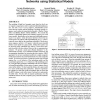1246 search results - page 13 / 250 » Activity Modeling Using Event Probability Sequences |
EDUTAINMENT
2007
Springer
14 years 1 months ago
2007
Springer
Most storytelling model approaches consider stories formed by sequences of a particular type of event. These sequences are mostly constructed using the inherent temporal characteri...
ER
2007
Springer
14 years 1 months ago
2007
Springer
There are a number of issues for information systems which are required to collect data urgently that are not well accommodated by current conceptual modelling methodologies and a...
VLDB
2007
ACM
14 years 7 months ago
2007
ACM
The modeling of high level semantic events from low level sensor signals is important in order to understand distributed phenomena. For such content-modeling purposes, transformat...
VC
2008
13 years 7 months ago
2008
Animation authoring involves an author's interaction with a scene, resulting in varying scene complexity for a given animation sequence. In such a varying environment, detecti...
ECAI
2004
Springer
14 years 1 months ago
2004
Springer
The Hierarchical Hidden Markov Model (HHMM) is a well formalized tool suitable to model complex patterns in long temporal or spatial sequences. Even if effective algorithms are ava...

